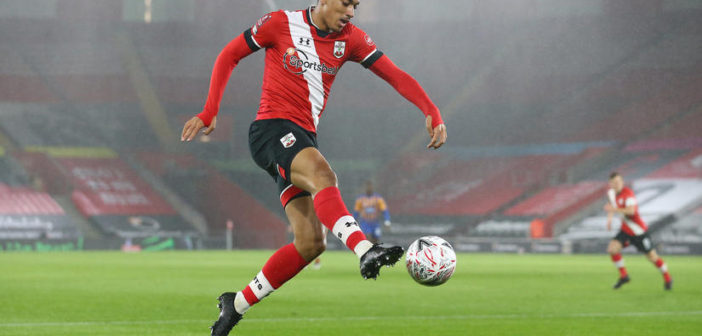I hereby put forward to you a theory.
Yan Valery is the only victim that emerged from Southampton’s tactical transformation. The only casualty in Ralph Hasenhuttl’s switch to a back four.
I also present to you another theory: Yan Valery displays all the hallmarks of a quintessential, perhaps even retro, early millennial right winger.
But for now, let’s begin with hypothesis one.
It was November 2019 when Ralph Hasenhuttl finally decided to throw all his coaching notes into one standalone playbook. The 2-2 draw at the Emirates marked a watershed moment in the relationship between coach and club, the moment where the Austrian drew a line in the sand and fully embraced his favoured 4-2-2-2 system.
Results speak for themselves. Aesthetically, the club appear more refined and defined, a far cry to the anarchy that had been running amok in the days and years following Ronald Koeman’s departure. What emanated after the tactical shift was overwhelmingly positive.
Well, that is unless you’re Yan Valery.
“You never know with the COVID situation. Suddenly you have players out so you need every player here,” Ralph Hasenhuttl said after Southampton’s 2-0 victory over Shrewsbury Town.
It was a telling response from the Saints boss after a question had been postulated over doubts towards Valery’s future. Essentially, Hasenhuttl was explaining external, undeterminable factors made him feel compelled to keep peripheral figures such as Valery at the club for the sake of an extra body. It was an apt retort indicative of the fallen standing the Frenchman has suffered over the past 18 months.
There was a time when Valery wasn’t just another player or an extra spot on the bench (well in the Kingsland stand now). It wasn’t so long ago that he had been on track to achieve eminent success on the south coast and had become the fresh-faced poster boy that could not only exhibit Saints’ resurgence in academy talent, but also their extensive scouting system across the world.
Making his first full debut in Mark Hughes’s final game against Manchester United in December 2018, Valery was on the cusp of the first-team picture when Hasenhuttl arrived. He soon established himself as a vital cog in the early origins of the Austrian’s 5-2-3 set-up, where his slender, triathlete build proved conducive to aggressive, powerful wide-play from the right wing-back position.
But Valery’s fortunes would soon mirror the club as a general malaise set-in. Opposition team’s began to expose and eventually play on the Parisian’s discernible physical and technical shortcomings, cajoling him into precarious positions and testing frail confidence.
Valery’s propensity to get stuck under aerial balls and show signs of self-implosion when under the first inklings of pressure meant progress became stagnated. Hasenhuttl’s switch to a back-four further intensified the spotlight on the 21-year-old’s vulnerability defensively, with reduced cover behind him meaning greater significance placed on his ability to defend one-against-one.
Hasenhuttl wants his players to be malleable and quickly acclimatise themselves to his bespoke coaching methods. Criticism aimed towards Valery’s seeming incapacity to be sculpted by Hasenhuttl’s hands were fair but other mitigating factors have also played their part. It must be noted that a sustained spell out following a troubled bout with glandular fever did not help matters.
_____________________________________________________________________________
Now onto this writer’s second theory.
Yan Valery is better than you think. He just needs to play 15 yards higher. In fact, he may turn out to be a somewhat proficient right midfielder.
Before I begin to speak in hyperbolic rhetoric, I must say it’s unlikely he will imitate the success of a certain former predecessor and transform from an introverted full-back to all-encompassing winger.
He might not be the next Gareth Bale. But he still has value – which could only grow in the ensuing seasons.
What is apparent is the young man from the suburbs of the French capital does his best work in the attacking half. Throughout the game against Shrewsbury, there was a marked difference in confidence and decision- making on the ball once over the halfway line.
Much of Southampton’s offensive threat came via the flanks, with Kgagelo Chauke, born in 2003 (makes you feel old at just reading that, I know), dropping deep when the centre-backs were in possession. This, in turn, allowed Yan Valery to take up a position high and wide, almost as an auxiliary right midfielder.
Invariably, the repeated patterns of the match did lend itself to Valery’s strengths. Some might say it was a terribly helpful game to make your return, especially given the tumultuous experience he endured the previous occasion he started a match.
After all, Shrewsbury sat in a mid-to-low block for much of the blustery evening, giving Saints players plenty of respite on the ball to assess the landscape in front of them. Saints had 74 percent possession and spent most of their time running and passing forwards, ensuring the only tempestuous vortex that threatened was from the heavens above.
Instead of being hooked at half time akin to Arsenal in June, Valery was a constant threat going forwards, with manipulative close control coaxing Shrewsbury’s left wing-back to lunge in. Valery’s quick, assertive running in their half – we will come on to his lapses of concentration in his own half – may have been the reason for Shrewsbury’s tactical change after the break. A 5-3-2 became a 5-4-1 with caretaker boss Aaron Wilbraham doubling up his players in wide areas.
Yan Valery’s innate tendency to tease full-backs to dive in before dropping his shoulder, change gears and driving to the byline is reminiscent of wingers in the early 2000’s, when there was heavy emphasis on players playing on their natural side and deliver deep overarching crosses into the box.
Goalscoring metrics were not seen as valuable nor as a real cornerstone of a team’s success. They were expected to chip in with the odd goal, but more often that not, their remit consisted of stretching teams through providing an outlet out wide.
While football’s various fashion trends tend to work cyclical, having a player that can hold width and become a crossing threat from 1v1 offensive positions may come to be quite handy for Hasenhuttl’s men, as this writer wrote last month.
Valery attempted three shots and once again, reflected in his goal against Tottenham two seasons ago, showed a penchant to arrive at the back post when the ball is delivered from the opposing side.
The image below is a tactical illustration of a football pitch, where the field is broken down into 18 zones. Some coaches utilise graphs like this to explain nuanced positional information to players. The 18 zones present a tactical and positional framework for players to visually learn from, as opposed to a coach sticking a hand out, and say ‘play there lad.’

From what we have seen from him and further evidence from the match against Shrewsbury, Yan Valery is comfortable having carte blanche in zones 15 and 18, where he can make use of his natural attacking instincts of which his slender, athletic frame prove conducive. In those two sectors, he can link well with players in close proximity and use his gifted ability to disguise a change of pace.
The much deeper problems lie in the zones where the lower numbers are. When playing in reverse, Valery can occasionally appear to cut an awkward figure, a paradox to his marauding exertions going forward.
A case in point came in the eighth minute, when a horizontal ball was played to the Frenchman on the cusp of the attacking half. The straightforward pass had begun to make its way to Valery before Shaun Whalley, Shrewsbury closest player, had started to set-off to apply pressure on the ball. This seemed to hurry the full-back as the ball ran under his foot and out for a throw-in.
A look up to the sky was then proceeded by hearing a shout from 30 yards away – a cry of “switch on Yan!” arrived from Fraser Forster.
Later on in the first half, Yan Valery became the source of Hasenhuttl’s frustrations after a square pass to Kgagelo Chauke allowed for an infrequent Shrewsbury press to have success and create a dangerous opening. Hasenhuttl quickly gesticulated that the ball should have gone down the line, rather than playing a risky pass into a congested area.
Without the ball, there was ample indication to suggest the same fragilities exist when in direct duels. The visitor’s best chance of the first half came after Valery overeagerness to nick the ball resulted in a hurried dive in and easily skipped over by Shrewsbury’s Harry Chapman. The eventual shot was relatively tame but could have given Forster an awkward save to make.
In a threadbare squad and a team that Tuesday night made Yan Valery one of the more experienced veterans in the team – disclaimer: he is still only 21-years-old – evolving and refining his positioning may give Hasenhuttl more depth to a depleted group as well as another facet to Southampton’s attack.
Saints’ attacking sword has been blunted by a heavy insistence to funnel any creative patterns through central areas of the pitch. Teams have begun cottoning onto the direction of which Southampton thrust their blade and consequently, have made those avenues fraught with midfield bodies.
Therefore, having a player like Valery, who could drive towards the byline with pace and power may just shift the angle of attack. The full-back’s enterprising excursions were put to an end five minutes from time, when Jan Bednarek played scrooge and told his closest teammate to tuck in and station himself ball side for the remainder of the game.
Valery’s three shots and seven touches in the opposition box suggest there could be something in sticking with him over the long haul. Though it will understandably take time to rebuild confidence and fully address his glaring drawbacks, both physically and technically, freeing a player from the shackles of defensive dependency could be somewhat liberating.
With just three clean sheets in 36 Premier League appearances (including one as a substitute when he indeed came on right midfield) it is probable the career of Yan Valery won’t end up with too much success if it stems from being a right-back for most of it.
It is difficult to judge Yan Valery’s attributes in a good or bad binary. He has fundamental flaws but also fundamental talent. Perhaps only when he is put 15 yards further forward will the latter begin to take shape. And who knows, he may just have a watershed moment of his own.
Follow us on Twitter @ProstInt
![Prost International [PINT]](https://prostinternational.com/wp-content/uploads/2021/08/PINTtFontLogoRoboto1536x78.jpg)



